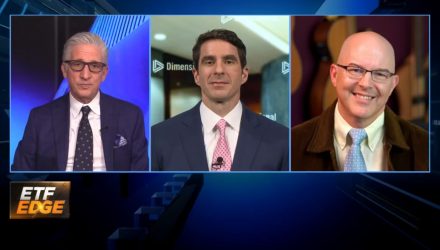On this week’s ETF Edge, host Bob Pisani spoke with VettaFi’s financial futurist Dave Nadig and Gerard O’Reilly from Dimensional Fund Advisors about what long-term investors should be doing with the S&P 500 nearing bear market territory.
As far as what history dictates and what O’Reilly is telling investors, “It’s important to set expectations correctly, and the right expectation for investing in markets is that they’re risky.” It’s important to stay disciplined, stay well-diversified, and have the right mix of stocks, cash, and bonds — especially during these volatile times.
There are ways to make things riskier, O’Reilly noted, and that’s by sacrificing diversification, chasing fads, or sacrificing discipline for panic when markets are volatile. All of those things will make it so that time stops working for the investor, so it’s really important to hold the line with patience and understanding.
Looking at the investment thesis and seeing what to expect based on past research, for Nadig, given all that’s taking place, it’s hard not to be excited about things based on international values. The Dimensional International Value ETF (DFIV) is a fund to take note of in that regard, as it’s performing well and is about the best international or value fund that can be found currently.
“That’s a victory, given the markets we’ve seen,” Nadig added.
With that in mind, Nadig spoke to the core points made by O’Reilly regarding diversification and cost control being the secret ingredient to handling a bear market. Investors go to lower-cost products, which could sometimes mean switching to an ETF out of a mutual fund and going toward broad diversification. These are the two things that work over the long term and two of the things that investors can actually control.
Sharp Market Downturn Cutting Ahead?
In consideration of what’s to come, as O’Reilly explained, a sharp downturn may indicate that a recession is in store for the real economy. That’s not always the case, but it does not suggest that investors should expect future declines. It may happen, but there are more likely positive returns to look forward to.
Essentially, a negative year does not imply another negative year. With that in mind, O’Reilly also pointed out good inflation versus bad inflation, noting that the key things to keep in mind are that investors can either outpace it or hedge it. Stocks and bonds tend to provide positive, real rates of return, even during high periods of inflation. Buying inflation-linked products allows investors to hedge it.
“You can plan for unexpected inflation,” O’Reilly stated. “You just can’t predict when it’s going to happen.”
Nadig noted that it’s important to recognize that the market is getting hit by a couple of different kinds of inflation all at once. Everything from food and energy inflation is coming from the war, and there will also be substantial supply chain problems coming out of Asia for the foreseeable future. These factors make it difficult to get a points solution that will protect investors from all of those potential sources.
Said Nadig, “I reiterate, a good, well-diversified portfolio with low-cost alternatives is probably your best bet.”
Listen to the ETF Edge Podcast with more thoughts from Dave Nadig:
For more news, information, and strategy, visit VettaFi.com.
